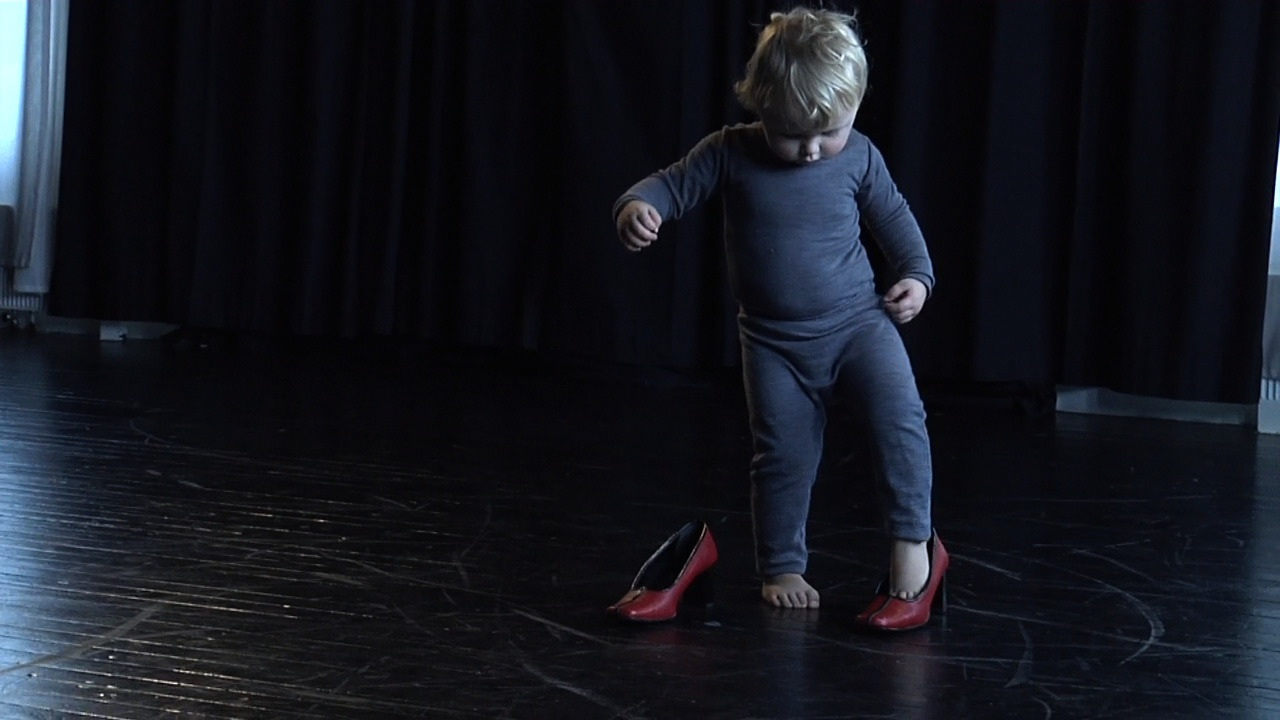Red Shoe Missing - Documentary, 2011 (11:22)
Art installation with red shoes, becoming a playground for children and improvisational space for artists. Sverresborg Trøndelag Folkemuseum, May 2011
It became necessary in this research process to investigate a new and more open space in which children are free to interact and play. The improvisational potential had to be explored within a new frame, and I had the opportunity to connect with the cultural and historical material of shoes and children’s toys in collaboration with Sverresborg Trøndelag Folk Museum in Trondheim.
The installation Red Shoe Missing was all about memories, childhood, playing, and nostalgia. It was inspired by my own childhood, as well as my parents’ and grandparents childhood, and was created to bridge the gap between adults’ often nostalgic childhood memories with children’s concrete, sensory world of discovery.
My new research questions were concerned with the significance of free play:
What happens when we invite small children (0- to 3-year-olds) to play in an art installation of red shoes, films, and old children’s toys and furniture?
What is the function and role of playing in children’s relation to art?
Will an art installation provide a better art experience for young children?
How will artistic improvisation affect the children’s playing?
The installation at the museum was situated in a large exhibition room (see exhibition vernissage). It was possible to move around freely, touch everything, and to use and play with red shoes and other objects. Red Shoe Missing was shaped for the audience of 0- to 3-year-olds and their accompanying adults: Kindergartens and nursery schools visited during the week, and parents and children at weekends. The toddlers were invited to play with shoes and rocking horses, and to extensively direct their own experiences.
The multimodal character of the installation of red shoes, rocking horses, old children’s furniture, tableaux, films,and dresses to creep into could in itself function as a room of experiences, without a defined dramaturgy or performing artists.
The experimentation included freely improvising artists in the installation space, which was conducted as open arrangements during weekends. The prearranged improvised artistic events were performed by a total of eleven improvisation artists distributed across four Sundays over the course of six weeks in the spring of 2011. Here the improvisations, which could last about 30 minutes, were entirely open, without any predetermined direction, choreography, or composition. Much like the children’s play, the improvisation artists were given no other framework than the space, the installations, the children, and the audience. We developed some opening and concluding strategies, but otherwise there were no formal regular, choreographic, compositional, or text-based guidelines.
In the research interviews with the performers, in which I asked questions about their experiences, it was evident that they experienced positive contact with the children and parents and felt that it was exciting to throw themselves into this free and improvised form of expression.
On the other hand, as an artist-researcher I experienced problems with both perspective and focus in my double role as a director and researcher (something that I will expand on in the analyses of phase 3). I collaborated, however, with a cinematographer to make a documentary film, which proved to be a decisive methodological factor in the research process.
The documentary is presented at the top of this page.
During collaboration with the filmmaker, I discovered that the act of filming became a kind of intuitive analytical process, and as such, filmmaking can provide a good research method. The research filming was mainly conducted to investigate how the open installation space worked as an artistic improvisation space for the artists, and a sort of playground for the children. During filming and editing, I discovered that the process brought my research questions to the surface by framing the often chaotic activity of the events. These questions became recognisable and allowed me to focus on significant moments.
On a methodological level, this offered an instrumental perspective, and my role as researcher was coloured by my eager wish to make the performance experience better for the children and the artists.
This dance film was projected from overhead onto a duvet spread out over the floor. Here the children could move around and experience their own and each other’s bodies in the light of the film.
The film portrays two busy, dancing mothers and their ambivalent relationships with their two small children (who are one and two years old), who are also present. The film gradually shifts focus and perspective from the mothers to the children. The content of the film was directed towards the adult audience, while the sensory experiences of the film’s light were made for the children.
